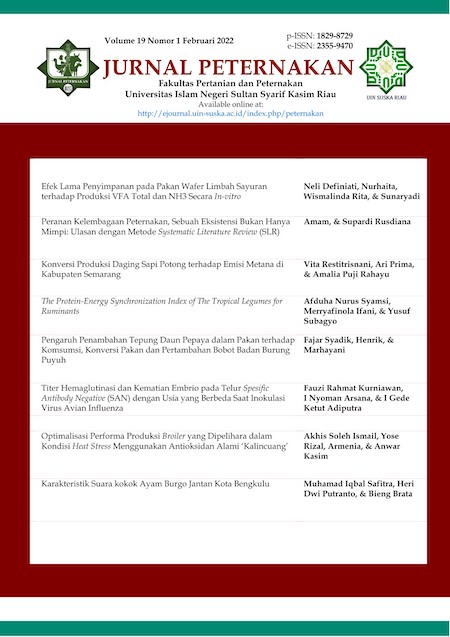Konversi Produksi Daging Sapi Potong Terhadap Emisi Metana Di Kabupaten Semarang
DOI:
https://doi.org/10.24014/jupet.v19i1.15580Keywords:
EmisiMetana, Daging, Sapi PotongAbstract
Penelitian ini bertujuan untuk mengevaluasi konversi produksi daging sapi potong terhadap emisi metana di Kabupaten Semarang berdasarkan data populasi dan produksi daging. Emisi metana dihitung menggunakan metode tier 1. Data populasi sapi potong dan produksi daging sapi di Kabupaten Semarang dari tahun 2015-2019 digunakan untuk menghitung konversi produksi daging dari sapi potong terhadap emisi metana. Populasi sapi potong jantan dewasa di Kabupaten Semarang dari tahun 2015-2018 mengalami penurunan secara berurutan menurun sebanyak 10,3%, 1,3%, 1,8% dan meningkat Kembali tahun 2019. Produksi daging menurun pada tahun 2016-2018, secara berurutan menurun sebesar 11,42%, 0,30% dan 1,95%. Pada tahun 2019 produksi daging meningkat sebesar 7,04%. Produktivitas tertinggi terdapat pada tahun 2015 (163,86 kg/ekor). Emisi metana dari fermentasi enterik dan pengelolaan kotoran ternak pada tahun 2015-2018 menunjukkan penurunan, danmeningkat pada tahun 2019. Rata-rata emisi metana dari fermentasi enterik yaitu 0,466 Gg CH4/tahun, sedangkan dari pengelolaan limbah kotoran yaitu 0,009917 Gg CH4/tahun.Rata-rata produksi daging sapi potong per cemaran metana yang dihasikan di Kabupaten Semarang sebesar 1,94-7.Angka konversi terbaik di tunjukkan pada tahun 2018 adalah sebesar 1,42-7.Dapat disimpulkan,meskipun jumlah populasi ternak menurun sedangkan produktivitas ternak ditingkatkan maka produksi daging akan meningkat, sehingga emisi metan per produksi daging dapat diturunkan.
References
Badan Pusat Statistik. 2019. Impor Daging Sejenis Lembu 2010-2019. Dari https://www.bps.go.id/statictable/2019/02/14/2011/impor-daging-sejenis-lembu-menurut-negara-asal-utama-2010-2019.html (Diunduh pada 27 Maret 2021)
Gerber, P., A. Hristov, B. Henderson, H. Makkar, J. Oh, C. Lee, R. Meinen, F. Montes, T. Ott, and J. Firkins, 2013. Technical options for the mitigation of direct methane and nitrous oxide emissions from livestock: a review. Animal 7, 220–234.
IPCC (2006). 2006 IPCC Guidelines for National Greenhouse Gas Inventories: Volume 4, Agriculture, Forestry and Other Land Use, Eggleston H.S., Buendia L.,Miwa K., Ngara T. and Tanabe K. (eds). Published: IGES, Japan
Jiao, H., T. Yan, D. A. Wills, A. F. Carson, and D. A. McDowell. 2014. Development of prediction models for quantification of total methane emission from enteric fermentation of young Holstein cattle at various age. Agriculture, Ecosystems and Environment., 183: 160-166.
Mc Court, A., T. Yan, C. S. Mayne, and M. G. Porter. 2006. Prediction of methane output in beef cattle from indirect respiration calorimetric data. Intestinal Congress Series., 1293: 46-49.
Menezes, A.C.B., Filho, S.C.V., Silva, L.F.C.,Pacheco, M.V.C., Pereira, J.M.V., Rotta, P.P. and Rennó,L.N. (2016) Does a reduction in dietary crude protein content affect performance, nutrient requirements, nitrogen losses, and methane emissions in finishing Nellore bulls?Agric. Ecosyst. Environ., 223 : 239-249.
Porsavathdy P, Do H Q and Preston T R. 2017. Growth rate and feed conversion were improved, and emissions of methane reduced, when goats fed a basal diet of pigeon wood foliage (Trema orientalis) were supplemented with sun-dried cassava foliage (Manihot esculenta, Crantz) or water spinach (Ipomoea aquatica). Livestock Research for Rural Development. Volume 29, Article #68. Retrieved July 18, 2021, from http://www.lrrd.org/lrrd29/4/phho29068.html
Prima, A., E. Purbowati, E. Rianto and A. Purnomoadi. 2019. The effect of dietary protein levels on body weight gain, carcass production, nitrogen emission and efficiency of production related to emissions in thin tailed lambs. Veterinary world. 12: 72-78.
Steinfeld, H., Gerber, P., Wassenaar, T., Castel, V., Rosales, M., Haan, and C.De., 2006. Live-stock’s Long Shadow – Environmental Issues and Options. Food and Agriculture Organization of the United Nations, Rome, Italy.
Vlaming JB. 2008. Quantifying Variation in Estimated Methane Emission from Ruminants Using the SF6 Tracer Fechnique. A Thesis of Doctor of Phylosophy in Animal Science. Palmerston North (New Zealand): Massey University.
ZhongRong-Zhen, Fang Yi, Sun Hai-Xia, Wang Min, and Zhou Dao-Wei. 2016. Rumen methane output and fermentation characteristics of gramineous forage and leguminous forage at differing harvest dates determined using an in vitro gas production technique. Journal of Integrative Agriculture., 15 (2): 414-423.
Downloads
Published
Issue
Section
License
The Authors submitting a manuscript do so on the understanding that if accepted for publication, copyright of the article shall be assigned to Jurnal Peternakan and published by Fakultas Pertanian dan Peternakan Universitas Islam Negeri Sultan Syarif Kasim Riau as publisher of the journal.
Authors who publish with this journal agree to the following terms:
Authors automatically transfer the copyright to the journal and grant the journal right of first publication with the work simultaneously licensed under a Creative Commons (CC BY) that allows others to share the work with an acknowledgement of the work's authorship and initial publication in this journal.
Authors are able to enter into separate permission for non-exclusive distribution of the journal's published version of the work (e.g., post it to an institutional repository or publish it in a book), with an acknowledgement of its initial publication in this journal.
Authors are permitted and encouraged to post their work online (e.g., in institutional repositories or on their website) prior to and during the submission process, as it can lead to productive exchanges, as well as earlier and greater citation of published work (See The Effect of Open Access).

